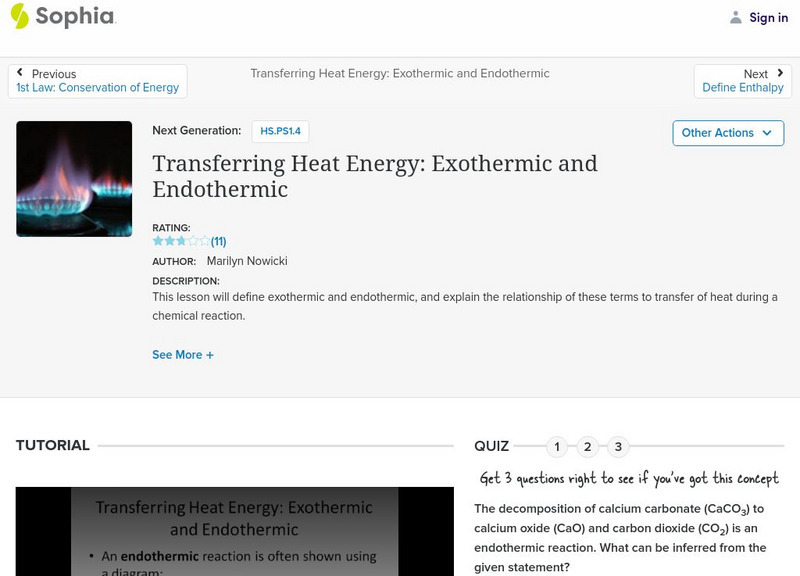Wonderscape
Understanding Energy Changes in Chemical Reactions
Explore the concept of energy changes in chemical reactions, including exothermic and endothermic reactions. Learn how chemical reactions can either release or absorb energy in the form of heat or light, with examples ranging from baking...
Curated Video
GCSE Chemistry - Exothermic and Endothermic Reactions #43
In this video we cover : - What exothermic and endothermic reactions are - What reaction profiles are and how to draw them - What activation energy is and how we show it on reaction profiles
FuseSchool
Collision Theory & Reactions Part 2
Learn about Collision Theory, what happens in a reaction and why some reactions are endothermic and some are exothermic.
FuseSchool
What Are Endothermic & Exothermic Reactions
An exothermic reaction gives off energy to the surroundings; like a fire giving off heat. An endothermic reaction takes in energy from the surroundings; like a snowman melting. Exothermic reactions transfer energy to the surroundings,...
Wonderscape
Science Kids: All About Chemical Reactions
This video is an educational program about physical and chemical changes in matter. The host uses examples such as baking cookies and a rusty bike fender to explain the concepts of physical properties of matter, chemical reactions,...
Curated OER
How to Blow Up a Balloon With Baking Soda & Vinegar
A simple combination of baking soda and vinegar creates enough carbon dioxide to blow up a balloon! It's an awesome illustration of chemical reactions for upper elementary learners, or use it with slightly older scientists to introduce...
JFR Science
Le Chatelier's Principle
Sometimes chemistry is a balancing act. Get to know Le Chatelier's Principle with a video from the JFR Science playlist. The narrator discusses pressure, temperature, and concentration in chemical reactions and how they affect the...
American Chemical Society
Exothermic and Endothermic Reactions
What happens when chemical bonds break and form? Science scholars explore the movement of energy in a chemical system by watching a well-rounded video. The narrators illustrate exothermic and endothermic reactions in terms of temperature...
Teacher's Pet
Le Châtelier
How do systems in equilibrium adjust to changes? Junior chemists examine Le Chatelier's Principle using a short video. The narrator illustrates how changing concentration, temperature, and pressure shifts the balance of reactants and...
Fuse School
Limestone Cycle - Limestone, Quicklime and Slaked Lime
Calcium rocks! Well, in this case, calcium carbonate is a little more accurate. Part four in a series of seven, the video describes how the seashells of ages past compressed to form one of Earth's most useful sedimentary rock resources....
Fuse School
What Are Endothermic and Exothermic Reactions?
Investigate the properties of endothermic and exothermic reactions with a detailed video lesson that defines exothermic and endothermic. The instructor explains the properties of each reaction and gives several examples of each.
Fuse School
Collision Theory and Reactions—Part 2
Get a positive reaction from your class as they explore the energy of reactions through a video analysis. The second lesson in a series of 35 explains energy absorption and release during chemical reactions. Graphs track the energy to...
Crash Course
Energy and Chemistry
Everything around you is related to chemistry and more specifically, the energy within a system. The video explores how energy, in its different forms, changes after conversion — given off as heat or absorbed as heat in...
Berkeley University of California
Heterogeneous Equilibrium
When performing a gas lab, we are often under pressure. A four-video set offers a brief explanation of Henry's law and demonstrates a lab. The last two videos prompt learners to complete brief quizzes over the material.
TED-Ed
What Triggers a Chemical Reaction?
Chemical reactions are happening all around us every second of every day, but what exactly causes these changes to occur? Using easy-to-understand analogies, this video explains how the concepts of enthalpy and entropy determine the ways...
TED-Ed
The Chemistry of Cold Packs
How can it take water hours to freeze, but a cold pack can go from room temperature to near freezing in an matter of moments? Find out with this short video that explores the endothermic reaction that make these modern marvels possible.
Educreations
Entropy & Free Energy
An understanding of chemical reactions really boils down to two concepts: entropy and enthalpy. Follow along with this instructional video as it explains how these two principles are used to calculate Gibbs free-energy which...
Sophia Learning
Sophia: Transferring Heat Energy: Exothermic and Endothermic
This lesson will define exothermic and endothermic, and explain the relationship of these terms to transfer of heat during a chemical reaction.
Bozeman Science
Bozeman Science: Ap Chemistry: Endothermic & Exothermic Reactions
In this video, Paul Andersen explains how heat can be absorbed in endothermic or released in exothermic reactions. An energy diagram can be used to show energy movements in these reactions and temperature can be used to measure them...














